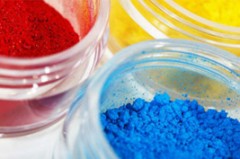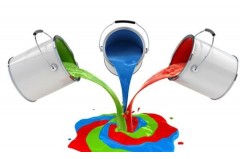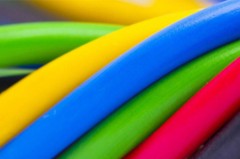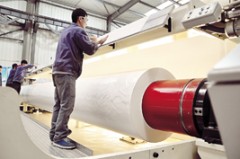Application
Precipitated barium sulfate – How does it work in various coatings?
Precipitated barium sulfate as a standard product has been widely used in various industries: coatings, plastics, rubber, adhesives, ink and so on. Its common function often involves serving as a filler in coatings to augment their mechanical attributes. Coatings are divided into various types according to their market segment characteristics, how does precipitated barium sulfate work in different coating systems?
For high solid content coatings
For a high solid gloss finish, precipitated barium sulfate with a particle size of about 0.7-0.8 μm is required. Using a larger particle size will affect the surface gloss. Due to the higher specific surface area, the smaller the particle size, the more substrate needs to be used. Therefore, high fill ratios and high solids content are almost impossible.
A precipitated barium sulfate with a particle size of 0.7μm prevents flocculation and separation of pigments, which can reduce the amount of pigments to very low levels. 0.7 μm precipitated barium sulfate actually has no effect on viscosity over a wide addition range, so a higher percentage of precipitated barium sulfate can be added in a given formulation and the luster will not be affected. Therefore, precipitated barium sulfate provides a great opportunity to reduce VOC and reduce formulation costs as it can replace more expensive pigments.

In addition to white or brightly colored coatings, it is worth mentioning that white precipitated barium sulfate powder can also be used for pure black coatings without affecting black. This is because the precipitated barium has a similar refractive index to commonly used resins, so the precipitated barium sulfate mixed into the system is not white but transparent. As a result, the carbon black coating does not turn grey.
Precipitation of barium sulfate can also reduce the VOC of the black coating. There are great differences between carbon black and precipitated barium sulfate in terms of oil absorption rate and specific surface area. By anti-flocculation, the precipitated barium sulfate can replace a large amount of carbon black, reduce the total amount of substrate, reduce viscosity, and effectively reduce VOC.
For powder coating
Powder coatings are one of the fast growing markets in the coatings industry. Precipitated barium sulfate has become an indispensable component of powder coatings due to its special properties, low demand for substrate and excellent dispersion. The specific gravity of precipitated barium sulfate is as high as titanium dioxide, so even when using ultrafine powders, there is an opportunity to make powder coatings without over-spraying. In a typical powder coating formulation, the mechanical properties of the surface treatment are affected by the particle size of the precipitated barium sulfate. The smaller the particle size, the better the performance.

For water-based coatings
Due to its chemical inertiness and insolubility, precipitated barium sulfate is as suitable for waterborne coatings as traditional coatings. It has been shown that even in electrophoretic coatings (whose requirements for particle deposition or wettability are very complex), micropowder precipitated barium sulfate can work effectively. The usual substitution of precipitated barium sulfate for titanium dioxide is in the range of 10-30%.

For conductive coatings
The use of inorganic treatment grade of special precipitated barium sulfate to create a bright conductive coating. The electrical conductivity through the coating is provided by the inorganic semiconductor, while the other beneficial properties of the precipitated barium sulfate remain unchanged.
As with any other conventional conductive system, a certain filling rate must be reached before the resistivity suddenly drops to form a conductive network. First, the electrical resistivity of the circuit is reduced by several orders of magnitude, while the electrical resistivity of the additional circuit is decreased by a small amount. The penetration point can vary over a wide range of fill ratios, and by controlled flocculation it is possible to form loops that long ago were formed only by overlaying. Once the solvent has been successfully converted to a thermodynamically unsuitable solvent, then the use of organic additives is beneficial.
Needless to say, conductive coatings can be combined with any other pigment or filler without loss of conductivity. When the raw material is smaller than titanium dioxide, the addition of pigments increases the surface resistivity because the tiny particles are stacked together to form an additional circuit.
Some of the possible uses and functions of non-black conductive coatings are listed below:
- Plastic coating – electrostatic spraying is allowed
- Coil coating – for clean rooms
- Printing inks – for electronic component packaging
- Floor paint – prevents electrical discharge
- PET/PP films and foils – obtain antistatic properties
For automotive paint
It is well known that precipitated barium sulfate can be used in all coatings of automotive coatings. Just as precipitated barium sulfate can replace some titanium dioxide in electrophoretic paints, it can also be used in primers and topcoats due to its excellent dispersion and weather resistance. The precipitated barium sulfate stabilizes the pigment, preventing flocculation, wear, and excessive baking.
Due to the small particle size of ultrafine precipitated barium sulfate, they are completely transparent even at high filling levels. Therefore, they can be used to increase the solid content of metal coatings without causing color changes. They can also improve the flatness of the sheet metal.

Our precipitated barium sulfate
Due to its ultra-fine particle size, chemical inertness and good transparency, precipitated barium sulfate has been used by coating manufacturers around the world to fill a variety of coatings to reduce the total cost of materials and improve mechanical properties. Although it is a national standard product, the newly coated precipitated barium sulfate has better particle size distribution, higher whiteness and lower oil absorption rate. In addition to the above various coatings, precipitated barium sulfate can also be used in plastics, rubber, friction materials and other polymer industries.





